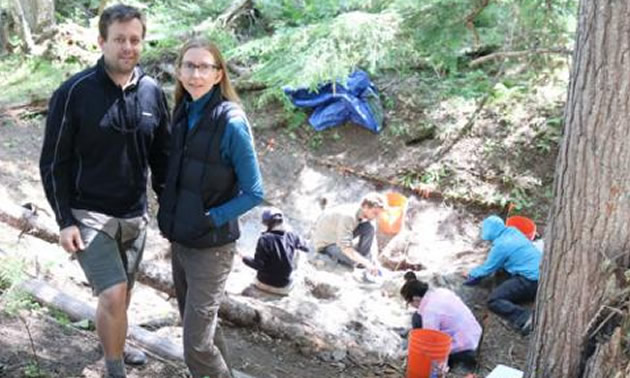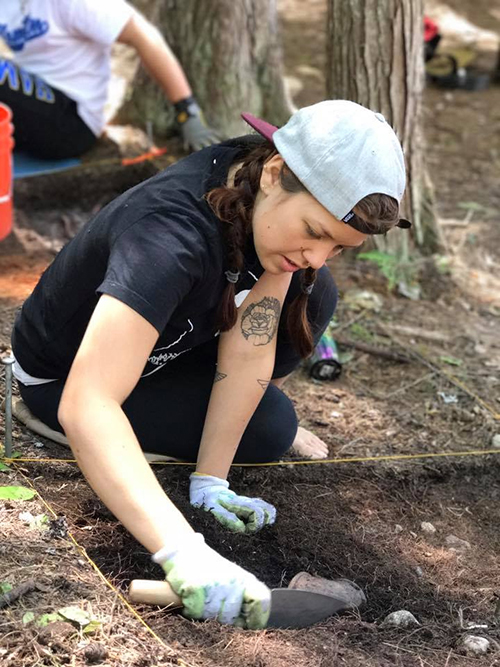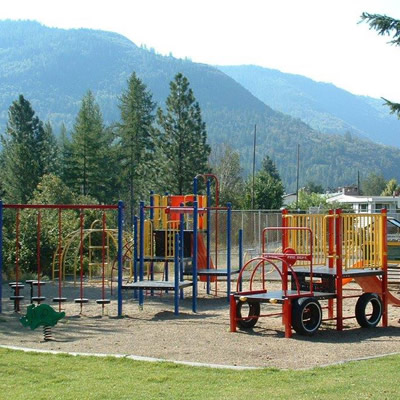Slocan Narrows Archaeological Project gets students hands-on with history
The project is coordinated by Hamilton College, a private liberal arts school located in Clinton, New York.

Dr. Nathan Goodale (left) and Alissa Nauman (right) are the Hamilton College educators heading up the project excavating and documenting the pithouses found along the Slocan River. — Photo courtesy Slocan Narrows Archeological Project
Hamilton College’s Slocan Narrows Archaeological Project has returned to the shores of the Slocan River bringing post-secondary students from across the continent to excavate and document history uncovered in a cluster of First Nations pithouses.
Selkirk College’s Reyna Brown is a local student participating in the archeological dig taking place this year. Uncovering links to the past provides a new perspective on the lands in which she grew up and valuable experience as she pursues a degree in Anthropology.
“That this is offered here is very cool,” Brown says. “I am the only student that comes from this area. I grew up in the Slocan Valley and I’m really at home in the area. I love these mountains and I’ve spent most of my life hiking around in them… but I’ve never really considered what lies underneath.”
Brown had never really considered herself interested in history either. Then, one day her Grade 12 Social Studies teacher at Self Design High engaged the class in a World War Two lesson that awakened an appreciation for the past. The historic battle went from something read about in text books to a living exercise that had everyone imagining they were involved.
“My teacher brought everything to life and it got me thinking of history in a new way,” Brown says. “Suddenly, I was fascinated. I couldn’t stop reading. I was inspired by finding connections between history and current events.”
Devouring history, Brown’s eagerness led her to Selkirk College where she enroled in the School of University Arts & Sciences focusing on Anthropology. Her first year of post-secondary complete, the 20-year-old is currently the youngest student on location at the Slocan Narrows Archaeological Project.
“I like getting my hands in it. I like the physical and being able to see things,” says Brown, excited to head to the dig which started in early June.

Selkirk College’s Reyna Brown is a local student participating in Hamilton College’s Slocan Narrows Archaeological Project alongside the Slocan River. Uncovering artifacts from Indigenous pit houses in the area is a valuable experience for the Anthropology enthusiast. — Photo courtesy Slocan Narrows Archeological Project
The project is coordinated by Hamilton College, a private liberal arts school located in Clinton, New York. Hamilton College Associate Professor of Anthropology Dr. Nathan Goodale and Hamilton College Instructor of Anthropology Alissa Nauman have brought students to the site every second year. Selkirk College students have been involved since 2011.
Almost 40 pithouses have been identified along the banks of the Slocan River just north of Lemon Creek. Radiocarbon dating has revealed that four different periods of human occupation by Indigenous people from approximately 3,105 years ago to the late 18th Century.
All students live in a camp near the site and spend the entire six weeks immersed in the project. The field school trains students in excavation, survey, equipment used in mapping, as well as the archaeology, ethnography, and oral tradition of the interior Pacific Northwest. Guest speakers are brought in to provide a deeper understanding of the importance of the work being done.
“Having Selkirk College students able to access an archeology field school in their own community, run by an elite U.S. college provides our students with incredible opportunities,” says Selkirk College Anthropology Instructor Lori Barkley. “Students from Hamilton College benefit from the local knowledge Selkirk students bring. When I was there last week to give a lecture, Rena was telling of roots they would encounter and how to harvest and use them. There is just so much formal and informal learning going on. The synergies between them all are amazing.”
Upon the completion of this course, students are qualified for employment in archaeology.
Brown will return to Selkirk College this fall to complete her two-year Associate Degree before transferring to complete her degree in Anthropology. She feels that she is thriving in the college environment, a different learning environment than she is used to coming from an alternative school system.
“It’s been really fascinating. My instructors are great – Lori Barkley has really inspired me – and my classes have been great,” she says.
Important Stories Uncovered
Barkley recommended Brown for the Slocan Narrows Archaeological Project.
“Nathan and Alissa could fill the school with their students but they go out of their way to make local connections,” says Barkley. “Reyna is the kind of student that Hamilton wants to include. She loves the outdoors, is local and positive. She’s an engaging student and a hard worker. Her own life story is fascinating. I knew it would be an excellent fit."
Brown has developed a strong interest in Indigenous history. That these pit houses are on unceded territory means “there’s an important story” she wants help tell. As she looks ahead to her career, Brown sees herself working with Indigenous issues in Canada.
“Anthropologists often work in distant locations and we are encouraged to do so because we can bring new perspective to other places,” says Brown. “But there is something valuable to working somewhere you really love, where you care and respect the land. We don’t have to go far away to find prehistory. There are interesting things to discover and issues to pay attention to here.”
The public is welcome to discover more about the Slocan Narrows Archaeological Project. An open house will take Sunday, July 9 from 10 to 1 p.m. Admission is free. The Slocan Narrows Pithouse Village can be found by taking Highway 6 north from Winlaw. Cross Lemon Creek and go to the Lemon Creek trailhead where signs will be set up to indicate parking. Wear comfortable shoes, bring a water bottle and pack bug spray.
Learn more about the School of University Arts & Sciences and check out Slocan Narrows Archaeological Project on Facebook.





Comments